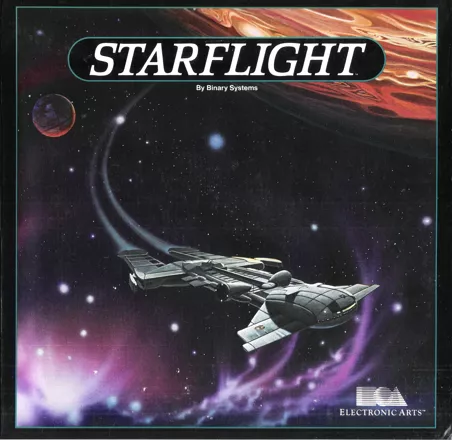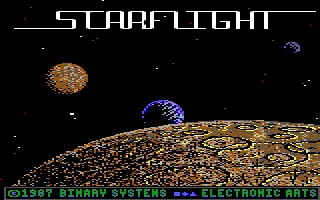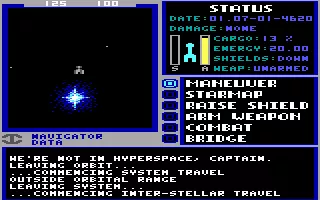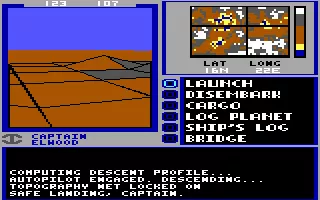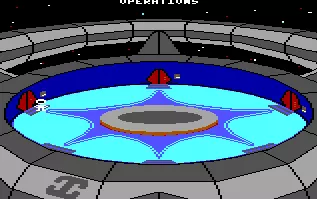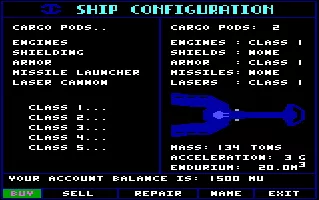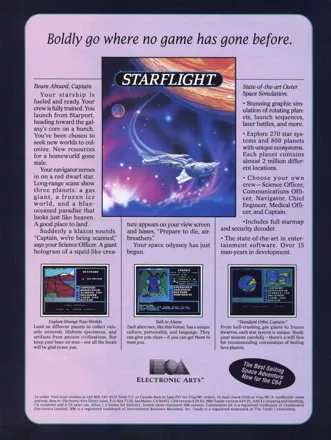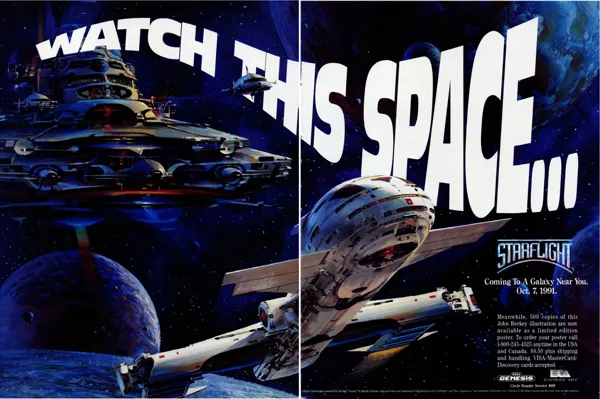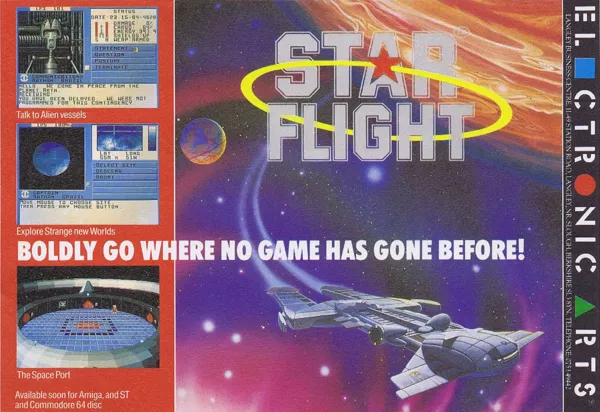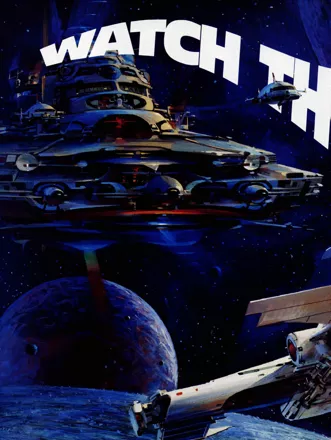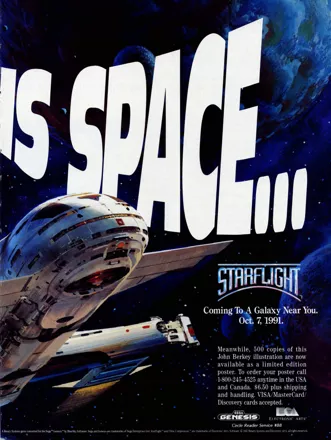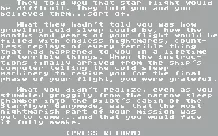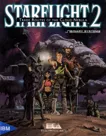Starflight
Description official descriptions
A long time ago, a great empire comprised of Humans, Velox, Thrynn and Elowan ruled the stars. The Empire's currency was an energy source called Endurium. But something happened and this empire is no more. Furthermore, the small colony world named Arth has forgotten this heritage and technology. A thousand years have since passed and the people of Arth have rediscovered archaeological evidence of their empire. Using these discoveries, they create spaceships and form the Interstel corporation to govern the fleet. It's time to take the first steps back into space... but could it be the same enemy that destroyed the Empire still exists?
Starflight is a space exploration game with role-playing elements. The game is completely non-linear, allowing the player to venture to any star system and explore any of the vast amount of available planets. The main plot is advanced by following cryptic clues either received as transmissions at the initial spaceport, or obtained as a result of successful communication with various alien races populating the universe.
The player must first form a crew, assign their positions and customize the spaceship before blasting off from spacedock. Besides the captain of the ship, a science officer, a navigator, an engineer, a communicator, and a doctor have to be assigned to the ship. The player can choose between Humans, Velox, Thrynn, Elowan, and Android races when creating the characters. Each profession usually has a racial counterpart with the highest proficiency in it. Except Androids, members of every race can be trained in their skills by spending the game's currency. In the starting location the player can also acquire better weapons, armor, and shields for the ship, as well as outfit it with cargo pods. Terrain vehicle can be customized as well.
Once out into space, the standard interface allows access to different crew members and navigation. The entire galaxy is unknown and it's up to the player to travel to distant planets to explore and land on them. Planets may be inhospitable, with harsh weather conditions and various terrain types. Using a top-down interface, a planetary lander will venture out with the task of finding minerals and biological data to transport back to Starport. These resources can be sold for MU, the game's currency.
Different alien races control the galaxy and it will be up to the player to approach them diplomatically or face them in combat. Depending on the communicator's skill, the player may conduct successful conversations by assuming different postures, requesting information, or answering questions posed by the aliens. Each race has a different attitude and requires different approaches to peacefully end the negotiations. If all else fails, or if the player so wishes, the player-controlled ship may engage the aliens in combat, which is presented as overhead arcade action sequences. Successful exploration of the galaxy and alien cultures will yield clues and new leads as to the fate of the Empire.
The Amiga version adds an auto-mining command. The Genesis version has updated graphics and sound, and is different in several aspects: locations of minerals and artifacts are different; there are new weapons for the ship and upgrades for the terrain vehicle; landing on planets is no longer automatic and must be controlled manually to avoid crashing; terrain vehicle exploration is more realistic, with visible weather conditions and various terrain types slowing down the vehicle.
Groups +
Screenshots
Promos
Credits (DOS version)
25 People (18 developers, 7 thanks) · View all
| Design | |
| Programming | |
| Music | |
| Documentation | |
| Producer | |
| Assistant Producers | |
| Technical Consultant | |
| Product Manager | |
| Art Director | |
| Package Design | |
| Package Illustrations | |
| Special thanks to | |
| [ full credits ] | |
Reviews
Critics
Average score: 81% (based on 28 ratings)
Players
Average score: 4.0 out of 5 (based on 95 ratings with 11 reviews)
The Good
This game opened many doors in the industry, including the epic space exploration game (see Star Control 2 for the latest and best iteration of this concept) and the "man-years" required to make such a game.
The ending is also one of the most impressive and influential story devices in the genre.
The Bad
The artifacts were too hard to figure out what the heck they did, and the timelimit to finish the game seems cruel (but justified in hindsight.) Also, the "yes/no" ending choice really bothers me from a design aspect, since there is only one real choice.
The Bottom Line
Anyone interested in game history must play this game.
DOS · by Tony Van (2796) · 2000
The 2nd Most Adictive Game I've Ever Played
The Good
This game was like a dream to me when it came out. The sci-fi genre on TV wasn't there as it wasn't in gaming. But with Starflight, I could be the space explorer/adventurer. I had a crew (all of whom I named after TOS characters) and a spaceship. Now to mine local planets for money to train my crew and improve my ship. But this is only part of the charm of Starflight. The storyline was well done with the manual starting you off with a very interesting tale of his failed adventures (this also provides some clues on game play). I enjoyed learning about what happened to these humans on the planet Arth and their old empire as well as learning about the ancients.
The Bad
Sometimes finding artifacts to help you could be tedious, especially if you didn't have a special artifact which would tell you where to land to find other unique artifacts. Also, once you solved the game, playing quickly became boring. Sure, you could bully all the races and destroy them at will. I actually managed to land on the Speimen (sp) home planet and destroy it. But once I'd done that, I had no more planet-killers and I never played again.
The Bottom Line
Bottom line, an entire quarter of college was wasted while I spent all my free time, class time, and even some work time playing this game. Ah, those were the days.
DOS · by AstroNerdBoy (35) · 2001
Snerg snerg snerg, and by the shimmering ball! This is the greatest game of all time.
The Good
The elegant title "Starflight" is a fitting evocation of this perfect space exploration sim's scope. Discover unique and fabulous alien races? Explore massive planets for ruins, minerals and powerful artifacts? Train an expert crew and patch together the most powerful ship in the galaxy? Decode lost layers of history that combine to form an exciting and profoundly effective sci fi plot? It's all here! It's all great! And it's all addictive.
One very affecting and glorious element present in all of Starflight's aspects is its concept of freedom. Freedom to explore, freedom to interact, freedom to do things your way at your own pace. The game can be completed almost instantly given the appropriate knowledge. The exciting part of the game is acquiring that knowledge, and it is provided in such a way that it makes full use of the player's imagination.
The player first gathers a crew, and launches from Spaceport to explore the galaxy. Immediately the player is provided with a few subtle hints about nearby alien activity and mysterious ruins on a local planet. From there, the universe of this game is a sandbox. But it isn't a "sandbox" in the increasingly dull "sim" mold, and it cheerfully sidesteps the disappointing "you found a +2 item!" reward systems or soulless "signpost" characters of most open-ended RPGs. It is immersive without stunning graphics, it is freewheeling despite the plot's linear nature, and it is incredibly convincing and addictive due to smart design. By far the critical component to all this success is that the game is designed to make demands on the player's imagination. The return on those demands is absolutely extraordinary.
The density of history in the game is a major factor. Evocative ruins and ancient messages are strewn all over the galaxy, with many planets providing evidence of either the seemingly inscrutable ancient civilization, or the decayed might of the Old Earth empire. As in epic Greek or Renaissance drama, events of such tantalizing grandeur cannot be effectively shown in the medium, so they are hinted at. A fragment of a message here, some information about the last base of an extinct planet-destroying invader race there, tips from the insect Veloxi captains about past galactic wars or a grand artifact of the ancients--all these leave the full visualization or conceptualization of the events to the player's imagination, which does a far better job with a little direction than any team of artists or writers could hope to accomplish.
Gamers make this point often with regard to text-based games, or games like Rogue or NetHack--sometimes a crude red "D" can inspire more fear and wonder in a player than a 3d bump/normal-mapped skeletally-animated dragon with four layers of texture/UV mapping, 5.1 roars and particle effect fiery breath. But that's not all--even given the best graphics money can buy, the story or background in modern games is often just spat out at the player in full detail, with disappointing cutscenes to fill in all the gaps, leaving the imagination no room to work its individualized magic. To make a geeky example, think how much more evocative and fascinating the Clone Wars seemed when their realization in the viewer's head was solely based on a few hinting lines of dialogue from Star Wars. And then think how dull and lacking in spirit all that heretofore fascinating past history became when fully realized and explained in film. A tragedy, I say! Trust in imagination is in dangerously short supply when producers and directors think they can show -everything-, down to the minutest detail and up to the most epic scope. As in all the best art, the creator should suggest a path for the imagination to go, and from even the crudest hints at form or ideas are wonderfully and magically filled in. This allows a productive dialogue between the creator -and- the audience, as opposed to the whole experience being defined under the purposed domination of the former. Feh!
All of Starflight works towards this end. The major plot is great in and of itself. The history of the ancients and the final truth of their existence is absolutely bursting with imaginative possibilities for the player, with no need to spell them out didactically. Knowledge of the Old Earth empire leads to fascinating artifacts, excavations of old battlefields, and the anthropological adventure of charting out an ancient civil war led by a human rebel named Harrison. The deadly secret of the silent and vicious Uhlek provides a great sideplot and the setting for Starflight's marvelous sequel all in one masterstroke. All this historical knowledge is not merely window dressing--it allows the player to unlock new areas in the game, discover useful items, and feel as though they are experiencing a living, breathing galaxy.
On that note each alien race has a personality not so much created by the semi-random blocks of text they spit out mechanically, but by the gaps in those blocks of text that the player is carefully guided to fill in.
A perfect example is the Spemin. The player at first may adopt an obsequious or friendly tone to these space blobs, but it quickly becomes apparent that they are fatuous bullies, and it's best to stand up to them. The wonderful shift in their attitude is fairly simple in terms of the programming, but to the player it is an intensely enjoyable (and very humorous) reward for figuring something out. It isn't a soulless item with increasingly higher arbitrary numbers that is your reward for most of the exploring you do in the game, it's a sense of accomplishment and more useful knowledge about the galaxy and its history, and the deadly threat that may exterminate almost all its denizens. The idea of the kind and wise Elowan or the cheerful but arrogant Veloxi going up in a puff of stardust means something to the player. Not because the player is told this should mean something, but because the player has decided it does.
There are so many unique planets to explore. So many colonizable worlds to recommend back to Starport for $$ and fame, so many cute asides from the developers (Rodium? Xenon and Borno? :-P), so much history and love in the game setting--it's just a wonder and a joy to play. Discovering Old Earth and its outposts, landing on a beautiful fractal world for the first time, fighting off humanoid hoppers and collecting valuable artifacts whilst finding old ruins and revealing last messages of lost civilizations. Greatness!
Modern game designers should take a close look at this game, and ask themselves what makes it so wonderful to so many different players. New players are discovering it and falling in love with it all the time, and it can truly be described as an ageless game.
The Bad
All the negative aspects in the end don't detract too much from the overall experience. The battle sequences are often pretty mindless, the mineral-mining aspect is a little too boring (though it is easily bypassed by instead searching for colonizable worlds for much more $$), and the ending is too short. You sometimes wish for your interactions with the alien races to have more lasting effects, but in the end this is understandable given the limitations of the era and of course keeping possibilities open to the player.
The Bottom Line
It is an interstellar tapestry on two 5.25" disks. It is love and imagination in blocky CGA. It is a glimpse of epic galactic history in fractals. It is the ultimate player experience, filled to bursting by Binary Systems with wit, love, and the most rewarding forms of interactivity. It cannot and will -never- be surpassed. It is an epochal masterwork for all fans of adventure or open-ended gameplay. There are two kinds of gamers--those who pay eternal homage to Starflight and those who haven't played it.
DOS · by J. P. Gray (115) · 2007
Discussion
| Subject | By | Date |
|---|---|---|
| MGers assemble! Which artist drew the cover? | Somebody bring me Sisko! (8) | Jul 4, 2008 |
Trivia
Advertisement
The advertising on the back of the box is strongly inspired by Star Trek, although the game itself is not. It shares a few elements with it, however.
Compaq
The Starflight reference card lists this helpful hint if playing on an original Compaq "luggable":
Compaq(tm) users with an external composite monitor should type Control-Alt-< at the DOS prompt before starting Starflight to activate the composite display output.
This means that Compaq users could play the game in 16 colors (instead of the CGA 4-color palette) as long as they hooked up a TV or composite monitor to the composite output.
Copyright notice
The DOS version of the game features a copyright notice written in the spirit of the game and reproduced below:
*INTERSTEL POLICE WARNING
As provided by the Galactic Treaty of 4410, this computer software product is hereby declared the Intellectual Property of the Human authors, Binary Systems. All rights are henceforth reserved in space and time.
Provision for the protection of Intellectual Property is covered under section 8.9.1A-F of the Intangible Property Act of 4506, ratified by all beings except the Gazurtoid.
Included in Section 8.9.1A-C is the provision for Interstel Corporate Police to enforce the Law.
WARNING: Any being caught with an unauthorized copy or version of this Software Product will be punished by Interstel Corporate Police. Punishment may include the destruction of the offending being.*
Additionally, players will be visited by an Interstel Police Vessel at some point in the game and forced to give a passcode. Oh, and it has level 75 shields.
Development
Starflight and Starflight 2 were written in a mixture of Forth (!!) and assembly.
In an interview, the creators stated that what they did for both games was to create the universe first, populated all the various races, and then let them tell their own version of the story. This is directly opposite to most modern designs, where you have the story first, and the art/universe come later.
EGA re-release
Electronic Arts re-issued Starflight packaged in a box (as opposed to the album-cover packaging) with proper EGA support a couple of years later its initial release, but this version had an extremely limited distribution and is considered very rare. The gameplay in this release is also slightly different, which is seemingly unintentional because the gameplay differences conflict with established rules (shields stay up in nebulas, etc.)
Extras
The package came with a colored starmap listing every single system in the game and their star class. One quickly learned to add the "wormhole" jumps to the map in order to save fuel and/or avoiding enemies.
Game design notes
The inside tri-fold lists notes from the game designers:
The Dream:
Back in 1982, we approached Electronic Arts with the idea of creating a universe on a disk that would let people experience the feeling of exploring the universe. It was an ambitious idea. We knew it would require a lot of time and the development of some new technology. We were more right than we knew.
The Cutting Room Floor:
We rewrote the game several times as we struggled to achieve our goals. We wanted the universe to convey a gigantic sense of space, complexity, and life. And we wanted an exciting fantasy role-playing game, with a wide spectrum of character interaction and activity. It seemed like whenever we were close to finalizing the script, we'd find another way to make the game more fun.
The Planet Builder:
About nine months after we started the actual programming, we came up with the idea for the fractal generator. A fractal generator so powerful that it could create surfaces in space. It took 6 man-years to create the technology, but it gave us the ability to cram 800 complex and unique planets into each game, instead of the 50 we'd had before. There are so many that even we haven't explored them all.
The Aliens:
To find the right names for each race, we wrote long profiles and histories for each, then tossed random syllables at each other for several days. To handle their languages, behavior, and combat-action, we had to devote months to building a sophisticated artificial intelligence system. We threw away the communications module three times before we had exactly what we wanted. Sometimes we wondered which would come first, flying to the stars in Starflight, or flying to the stars in real life.
Breathing Ammonia:
Once the fractal generator builds a planet, the eco-system generator creates environmental conditions for it, like gravity, atmosphere, minerals, and temperature. Once we took a journey back to Earth, only to find the eco-system generator had given it new continents and an ammonia atmosphere. It took two years to perfect the technology.
15 Man-Years Later:
The last several months were spent tying all the various technologies together. Because of the program's complexity and scope, the play-testing alone took months. But all that time and effort has proven worthwhile. We had a vision of what an outer space fantasy game could be, and now that vision is a reality.
Saving
For the DOS version of the game, all of the player's information is saved onto a single save file. For this reason, the game points out you NEED to make a backup and should not play off of the original disks. And also, the game needs to be saved prior to exiting or the progress can get stuck "in-progress".
Size
Starflight (and the sequel) contains over 800 planets, each with specific artifacts and minerals to find and mine--all on two 360K diskettes (which also have to share space with program code and graphics) and without needing more than 256K of RAM. Consider the following: You could go to any arbitrary planet, find a cluster of artifacts and take only one of the artifacts in the cluster, leave the planet, spend another 20 hours exploring other planets, fighting battles, saving the game, etc., then go back to that same planet and find everything exactly as you left it, including the cluster of artifacts with only one taken. This was (and still is) an astonishing technical achievement!
Awards
- Computer Gaming World
- August 1988 (Issue #50) – Introduced into the Hall of Fame
- November 1996 (15h anniversary issue) - #55 in the "150 Best Games of All Time" list
- Happy Computer
- Issue 01/1988 - Best Role Playing Game in 1987
- Power Play
- 1987 - Best MS-DOS Game '87
Information also contributed by Adam Baratz, Kasey Chang, PCGamer77 and WildKard
Analytics
Upgrade to MobyPro to view research rankings and price history! (when applicable)
Related Sites +
-
AtariMania (Electronic Arts, UK, Atari ST)
For Atari ST: game entry database; downloadable release; game packaging; advertisement; manuals; magazine reviews; additional material. -
Bones' Starflight page
A nostalgic rememberance of Starflight. -
DOSBox, an x86 emulator with DOS
Compatibility information page about the original game and its DOSBox versions. -
Lemon 64
For Commodore 64: game entry database; advertisement; magazine reviews; music; documentation; cover art; additional material. -
Lemon Amiga
For Amiga: game database entry; magazine reviews; music; manual; additional material. -
Macintosh Garden, an abandonware games archive
For Macintosh: reviews; game packaging; downloadable releases; manual; screenshots; additional material. -
Orbital StarPost Yards
Looking for Starflight? -
SECAT
A group of people working on another sequel to Starflight. -
StarFlight X: Proxima Nova
Fan fiction and a Starflight-based MUSH game. -
Starflight
Looking for Starflight? -
Starflight 1 Codewheel Code Generator
Automatically provides codes required for ship launch. -
Starflight Resource Pages
Fan site on Starflight and Straflight II, containing extensive guides and featuring a forum. -
The Starflight III project page
A group of people working on another sequel to Starflight. -
The Starflight and Starflight 2 fan page
Probably the most comprehensive Starflight and Starflight fan page in existance. Contains mini-interviews with the game designers, and has links to other Starflight pages. -
Wikipedia, the free encyclopedia
Encyclopaedic entry for the combined platforms of the game.
Identifiers +
Contribute
Are you familiar with this game? Help document and preserve this entry in video game history! If your contribution is approved, you will earn points and be credited as a contributor.
Contributors to this Entry
Game added by Trixter.
Genesis added by PCGamer77. Amiga added by Rebound Boy. Commodore 64 added by 80. Macintosh added by Terok Nor. Atari ST added by Belboz. Windows added by eWarrior.
Additional contributors: Shoddyan, Patrick Bregger, ZeTomes, click here to win an iPhone9SSSS.
Game added May 12, 1999. Last modified January 19, 2024.


